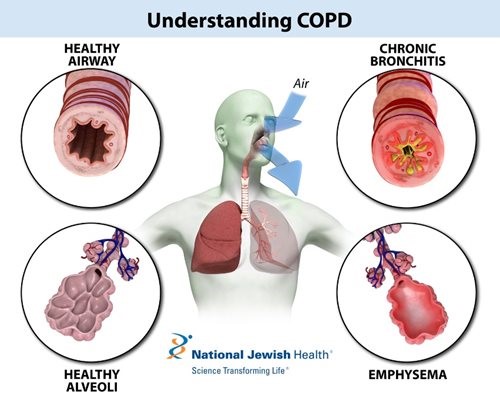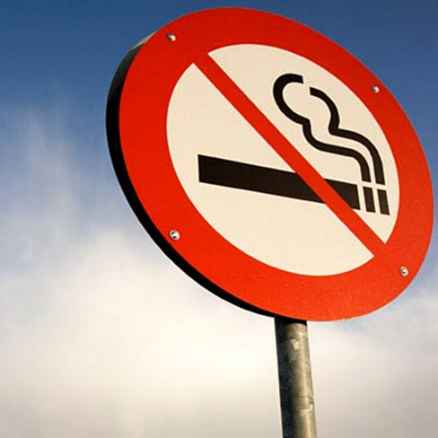Chronic Obstructive Pulmonary Disease (COPD) is a group of lung diseases which make breathing difficult. Chronic = it’s a long-term condition and does not go away Obstructive = your airways are narrowed, so it’s harder to breathe out quickly Pulmonary = it affects your lungs Disease = it’s a medical condition COPD includes a) chronic bronchitis, which is long-term inflammation of the airways AND b) emphysema, where the air sacs (alveoli) in the lungs are damaged. Sign and Symptoms of COPD Usually middle-aged adults are affected. Breathing gradually gets worse over time and interferes with your daily activities.
| Breathless | Cough | Phlegm |
| Wheeze | Chest infection | Tiredness |
| Weight loss | Chest pain | Coughing up blood |
| Lung cancer | Swollen ankles from collection of fluid (water) |
In these pictures you can see the difference between a healthy lung and a COPD lung.
 |
 |
| Reference: British Lung Foundation | Reference: National Jewish Health |
COPD not only harm your lungs it have many other effect on your body as a whole such as your heart, muscles, bones and brain.
Statistics of COPD in Malaysia The annual mortality rate per 100,000 people suffering from COPD in Malaysia has increased by 63.9% since 1990, an average of 2.8% a year. Thus far, for every 100,000 Malaysians, 19.5 of them have COPD. Prevention of COPD  1. Stop smoking As mentioned above, smoking damages healthy lung cells via alteration of normal enzymatic function in the body system and causes oxidative damages to normal structures of the lung. The Malaysian Clinical Guideline has stated that the risk of COPD is dose-related. In simple words: The more you smoke, the more likely that you’ll develop COPD. 2. Avoid secondhand smoke It is reported that at least 250 chemicals in second-hand smoke are toxic and carcinogenic (cancer causing). Second-hand smoke can originate from the exhalation of smoke called mainstream smoke by the smoker or emitted through burning of the end of a cigarette, also known as side stream smoke. Side stream smoke is generated at lower temperatures and under different conditions as compared to mainstream smoke, it is found to contain higher concentrations of many of the toxins found in inhaled cigarette smoke. The Canadian Lung Association has urged the public to stay away from hazardous secondhand smoke. Moreover, it has been scientifically proven that secondhand smoke increases the risk of COPD. In fact, the smoke itself puts you at risk for several other complications as well, such as lung cancer and heart disease.
1. Stop smoking As mentioned above, smoking damages healthy lung cells via alteration of normal enzymatic function in the body system and causes oxidative damages to normal structures of the lung. The Malaysian Clinical Guideline has stated that the risk of COPD is dose-related. In simple words: The more you smoke, the more likely that you’ll develop COPD. 2. Avoid secondhand smoke It is reported that at least 250 chemicals in second-hand smoke are toxic and carcinogenic (cancer causing). Second-hand smoke can originate from the exhalation of smoke called mainstream smoke by the smoker or emitted through burning of the end of a cigarette, also known as side stream smoke. Side stream smoke is generated at lower temperatures and under different conditions as compared to mainstream smoke, it is found to contain higher concentrations of many of the toxins found in inhaled cigarette smoke. The Canadian Lung Association has urged the public to stay away from hazardous secondhand smoke. Moreover, it has been scientifically proven that secondhand smoke increases the risk of COPD. In fact, the smoke itself puts you at risk for several other complications as well, such as lung cancer and heart disease.
| You can protect yourself and your loved ones by: |
| o Restricting someone from smoking in your house or in your car |
| o Asking people not to smoke around you and your children |
| o Going to restaurants and other premises that are smoke-free |
| o Teaching children to stay away from second-hand smoke |
Occupational exposure to secondhand smoke has been linked to an increased risk for heart disease and lung cancer among adult non-smokers. You can protect your colleagues or workers by: Having smoke-free workplace policies. Employers have rights to restrict workers from smoking while working or smoking within the premises. Separating smokers from non-smokers, cleaning the air, and ventilating buildings may help reduce exposure to secondhand smoke. 3. Occupational hazard Lung irritants such as air pollution, chemical fumes and dust can contribute to COPD. In particular, livestock farmers, workers who are exposed to strong chemical fumes and those who work in dusty areas are at risk of developing such conditions. For further reading please visit National Health Service COPD British Lung Foundation National Jewish Health National Heart, Lung and Blood Institute Health Grove. Chronic Obstructive Pulmonary Disease in Malaysia. Statistics on Overall Impact and Specific Effect on Demographic Groups. [Cited 2017 October 4]. The Canadian Lung Association. Second-hand smoke is also dangerous. 2016 October 12. [Cited 2017 October 3]. CDC. How to Protect Yourself and Your Loved Ones from Secondhand Smoke. 2015 September 21. [Cited 2017 October 3]. Management of Chronic Obstructive Pulmonary Disease 2nd Edition. Issued by the Ministry of Health of Malaysia. Authors: Bibi Zahra, Lee Tzun Kit, Prof Rumi Khajotia










